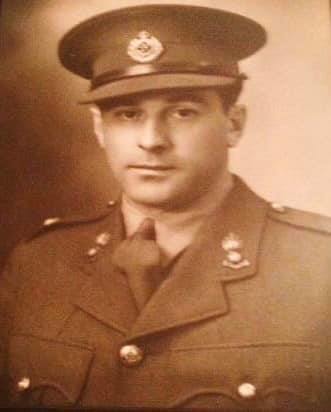Frederick was born on the family farm in Baldur, MB, the son of Mr. and Mrs. Charles A. Hamilton. After graduating in 1932 with a Bachelor of Scientific Agriculture degree from the University of Manitoba, he was an Agricultural Representative in the small community of Morris, MB.
In 1940, a friend contacted him and asked whether he wanted to join his group of officers and two days later, he had joined the Royal Canadian Engineers and was on his way to Camp Petawawa, ON. Later in the UK, he took commando training in preparation for the invasion of Sicily. On 9 July 1943, with a group of 20 hand-picked sappers, Lt Hamilton was the first Canadian to land in Sicily. He described his task as one of maintaining liaison between the HQ and the front lines. However, he explained he was too excited to leave the action at the front and seldom made his way back to the HQ. He was soon after assigned reconnaissance tasks and was later posted back to the 1st Field Company as a platoon commander. Lt Hamilton continued to serve throughout the Italian and Northwest European Campaign. He ended his service with the rank of major, having commanded the 1st Field Company at one point.
Fred often regaled his grandchildren with one particularly interesting war story. Apparently, at some point, he was blowing something up. While he thought everyone was out of the way, later admitted he did not check as carefully as he should have. After the charge went off, someone came walking out of the smoke and rubble demanding to know who was in charge. It was Field Marshal Montgomery! Fred identified himself, needless to say shaking in his boots, but Monty gave him a “Damn fine blow. Keep up the good work!” and kept on walking by.
Returning to Canada following the war, he joined the Manitoba Pool Elevators and rose through the ranks, retiring in 1975 as Executive Assistant to the President. He was also an economic advisor for the United Nations in 1955. In 1961, he was inducted into the Manitoba Order of the Buffalo Hunt at the National Conference on Farm Policy Research held in Winnipeg. He later wrote Service at Cost: A History of Manitoba Pool Elevators, 1925-1975, a history of the first 50 years in the operation of the Pool. He was married to Alice E. Stevenson. They had two daughters, Mary Ellen and Catherine Alice.
He died in Winnipeg on 26 January 1997 and was buried in the Chapel Lawn Memorial Gardens.
On 9 October 1943 when the leading brigade of 1 Canadian Division attacked Gambatesa and additional ammunition was urgently required, it was essential to open the only road to it. This road was thickly mined and blown in two places; it was under observation of the enemy and was being shelled heavily. Handicapped by rain rendering action of mine detectors uncertain and risky, and although under heavy enemy fire, Lieutenant Hamilton boldly led his platoon in clearing the mines and opened the road.
The determination and example displayed by this officer and his courageous leadership of his platoon enabled the ammunition and close support weapons of the battalion to be taken forward. This action by Lieutenant Hamilton was responsible to a large degree for the success of the operations, since it is doubtful if the momentum of the advance could have been maintained had it been impossible to move the supporting weapons and ammunition forward.
